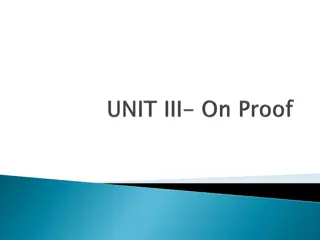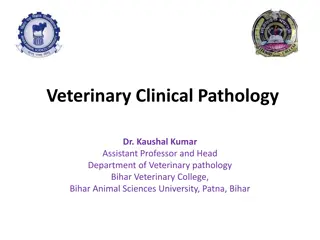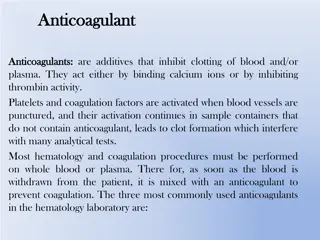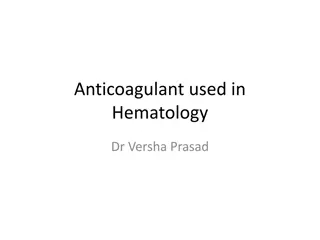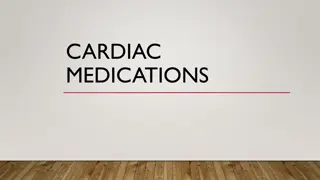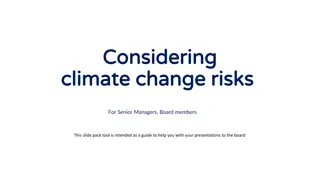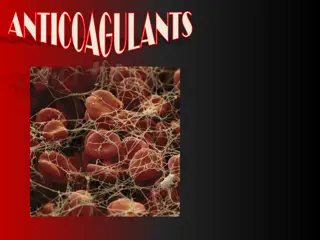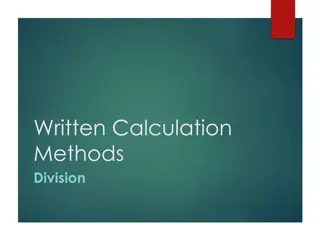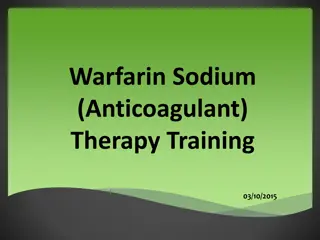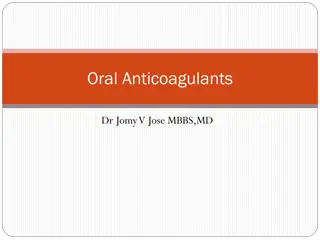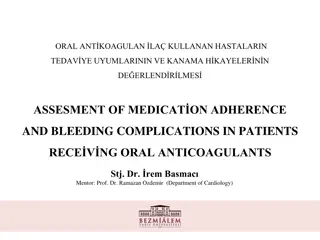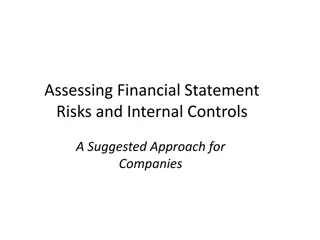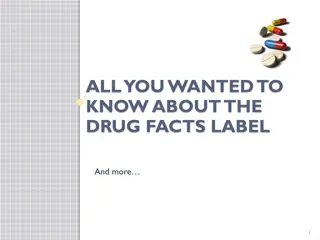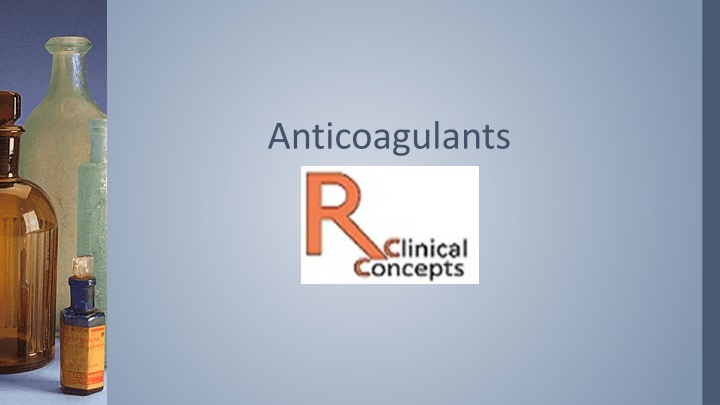
Anticoagulants - Key Facts and Risks
Anticoagulants, commonly known as blood thinners, play a crucial role in preventing blood clots. However, they come with risks such as major bleeding, with a 6.5% occurrence rate in patients. Despite being life-saving, anticoagulants like warfarin and heparin can also lead to fatal bleeding. It's important to understand how clots form and the various classes of anticoagulation drugs to manage these risks effectively. Look out for signs of bleeding like red or brown urine, black or bloody stool, and vomiting blood.
Download Presentation

Please find below an Image/Link to download the presentation.
The content on the website is provided AS IS for your information and personal use only. It may not be sold, licensed, or shared on other websites without obtaining consent from the author. If you encounter any issues during the download, it is possible that the publisher has removed the file from their server.
You are allowed to download the files provided on this website for personal or commercial use, subject to the condition that they are used lawfully. All files are the property of their respective owners.
The content on the website is provided AS IS for your information and personal use only. It may not be sold, licensed, or shared on other websites without obtaining consent from the author.
E N D
Presentation Transcript
Anticoagulants Did You Know? That major bleeding occurs in about 6.5% of patients on anticoagulants.. That s 1 patient in 15 and commonly, GI Bleeding. That 1% is fatal bleeding such as intracranial hemorrhage.
Anticoagulants Did You Know? Because of the narrow therapeutic window, anticoagulants such as warfarin and heparin frequently results in bleeding that can be life threating..
Anticoagulants Did You Know? They are sometimes referred to as blood thinners; they do not in fact thin the blood. These drugs will not dissolve clots that already have formed. They permit the body's natural process, fibrinolysis, to work to break down previously formed clots.
Anticoagulants Did You Know? Coagulation will begin instantaneously once a blood vessel has been severed.
Anticoagulants How are clots formed?
Anticoagulants- Platelets When bleeding occurs, platelets releases thromboxane that activate the platelet and become sticky These activated platelets begin adhering to the wall of the blood vessel at the site of bleeding
Anticoagulants Fibrinogen is converted to Fibrin by Thrombin. Fibrin strands stick to the exposed vessel wall, clumping together and forming a web-like complex of strands and red blood cells become caught up in the web, Causing a Clot
Anticoagulation classes Antiplatelet Aspirin, Clopidogrel, ASA/dipyridamole Vitamin K antagonist Coumadin, warfarin Thrombin inhibitors Heparin, LMWH, Pradaxa Xa factor inhibitors Xarelto, Eliquis, Arixtra, Savaysa
Signs and Symptoms of Bleeding Red or brown urine Black or bloody stool Vomiting of blood or material that looks like coffee grounds Bruising that develops without an injury Severe headache or stomach pain Joint pain, discomfort or swelling, especially after an injury
Signs and Symptoms of Bleeding Dizziness or weakness Bleeding from the gums Swelling or pain at an injection site Diarrhea, vomiting or inability to eat for more than 24 hours Fever
Anticoagulants Anticoagulants are used for; Acute coronary syndromes, Deep-vein thrombosis (DVT), Pulmonary embolism (PE), Heart surgery. Atrial Fib Patients with artificial heart valves.
Anticoagulants Question Who can tell me approximately when anticoagulants were first used to treat patients? 1 25 years ago 2 - 85 years ago 3 - 2,500 years ago
Anticoagulants A cattle disease in the Midwest in the 1920s causing bleeding was traced to spoiled sweet clover the cattle was eating. This substance was extracted and identified as coumarin at the University of Wisconsin. This led to the development of dicoumarol in 1941 and rat poison in 1954 Coumadin, warfarin.
Anticoagulants Coumadin, warfarin
Anticoagulants DID YOU KNOW? There are 803 known Drug interactions with Coumadin, warfarin Of that number, 208 are considered MAJOR!
Anticoagulants - Coumadin Warfarin, the only drug listed in this category. It is an oral anticoagulant that inhibits Vitamin K Vitamin K is an activator of coagulating factors II, VII, IX and X. Regular blood monitoring (international normalized ratio-INR) is done to check for effectiveness and safety.
Key interactions in the older patient involve Coumadin, warfarin INCREASE the EFFECT of Warfarin - Bleeding Warfarin with NSAIDS Warfarin and Sulfa Drugs Warfarin and Macrolides Warfarin and Quinolones Warfarin and Amiodarone Warfarin and Vitamin E
Key interactions in the older patient involve Coumadin, warfarin DECREASE the effect of Coumadin, warfarin Anticonvulsants Carbamazepine Tegretol Phenytoin Dilantin (+/-) Phenobarbital
Warfarin interactions in Older Patients Typical Food interactions with Warfarin, Raw and Boiled Green Vegetables with HIGH Vitamin K Levels Kale Spinach Turnip greens Parsley Mustard greens Avocado *(decreases ability to metabolize Coumadin) Brussel Sprouts Broccoli Romaine Lettuce Chard Green Tea Grapefruit*
Reversing an Anticoagulant HASHTI Hold the dose Antidote Support treatment (fluids) Hemostatic measures (surgical) Transfusion Investigate (source)
Reversing Coumadin 1 - Vitamin K Takes 4-24 hours for results 2 - Fresh Frozen Plasma Fluid overload & transfusion related acute lung injury 3 - Prothrombin Complex Concentrate Extremely rapid 30min
Dosing Adjustments in a NON-Bleeding Patient COUMADIN TARGET INR 2.0-3.0 I INR 3.6-4.0 I INR< 2.0 I INR 3.1-3.5 I INR 4.1-8.9 I INR> 9.0 I Hold 0-1 dose Hold 0-2 doses Hold 2 doses Increase 10-15% Decrease 0-10% Decrease 10-15% Decrease 10-15% Decrease 15-20% Possible Vit K 2.5mg I Plus Vit K 2.5-5mg I I I I Repeat INR Repeat INR Repeat INR Repeat INR Repeat INR within 1 week within 2 weeks within 1 week in 2 DAYS the NEXT day
Anticoagulants Thrombin Inhibitors
Anticoagulants In 1916, a pharmacologist at Johns Hopkins discovers HEPARIN Heparin from the Greek word HEPAR meaning liver. The liver produces Fibrinogen and Prothrombin.
Anticoagulants Heparin was delayed until 1930 until a water soluble preparation was developed. Later heparin was chemically altered by fractionation. Leading to low-molecular-weight heparins such as enoxaparin, LOVENOX
Anticoagulants - Heparins Heparin is an injectable anticoagulant that inhibits thrombin and factor Xa, factors necessary in the final stages of blood clotting cascade. There are two types of heparins: high molecular weight heparins High molecular weight heparins require blood monitoring to check the activated partial thromboplastin time aPTT to measure the "intrinsic pathway . low molecular weight heparins. (Lovenox) Low molecular weight heparins give a better anticoagulant response and do not need routine blood monitoring and for the most part is replacing Heparin therapy.
Anticoagulants Thrombin Inhibitors Heparin Sodium (heparin) Heparin Lock Flush (heparin flush) Lovenox (enoxaparin) Fragmin (dalteparin) Innohep (tinaparin) Pradaxa (dibigatran)
Reversing Thrombin inhibitors Heparin Short half-life, lasts up to 3 hours, Protamine reverses heparin, 1mg/100U heparin Adm in the last 4 hrs. CAUTION, 0.2% show anaphylaxis, with a 30% mortality rate. Lovenox 1mg protamine for every 1 mg enoxaparin if <8Hr. Pradaxa Adm Praxbind, Approved by FDA IN 2015, works in minutes with almost an immediate response.
Anticoagulants Xa Factor Inhibitors
Anticoagulants Factor Xa is an attractive target for the design of new oral anticoagulants because of the unique role factor Xa plays in the coagulation cascade as a connection between the extrinsic and intrinsic pathways
Anticoagulants Factor Xa Inhibitors Arixtra (fondaparinux) Xarelto (rivaroxaban) Eliquis (apixaban) Savaysa (edoxaban)
Factor Xa Inhibitors It's less of a risk with the new medications. And since they wear off faster than warfarin, bleeding problems may not be as serious when they happen. No real reversing agents yet, but have a short half-life . You don't need as many routine blood tests. No Vitamin K issues and vegetables Minimal dose adjustments Here are some drugs that don't mix well, but not nearly as many as with warfarin.
Factor Xa Inhibitors Medications to watch with Xa factor Inhibitors Amiodarone CrCl <80, Increase effect Azithromycin CrCl <80, Increased Effect Coreg CrCl <80, Increased Effect Cipro CrCl <80, Increased Effect Dilantin & Pb Decreased Effect Diltiazem CrCl < 80. Increased effect NSAIDS Increased Effect SSRIs and SNRI Increased Effect Tegretol Decreased Effect Trazodone Increased effect
Factor Xa Inhibitors When not to switch to a Xa factor inhibitor? Epidural/Spinal Hematoma Risk Stay on warfarin if you have kidney failure or if you have mechanical heart valves Monitor for CrCl <80
Reversing Factor Xa Inhibitors Arixtra, Xarelto, Eliquis, Savaysa FEIBATM (aPCC): clotting factors II, IX, and X and activated factor VII Kcentra (PCC) clotting factors II, VII, IX and X Andexanet Alfa reverses Eliquis and Xarelto within 3-5 minutes. In Phase III Trials now .
Factor Xa Inhibitors QUESTION? Should we change the patients on Coumadin, warfarin to the new Xa Factor inhibitors? If the patient is on warfarin, they are stable, and don't have bleeding problems, and labs are not an issue there's generally not a compelling reason to switch."


